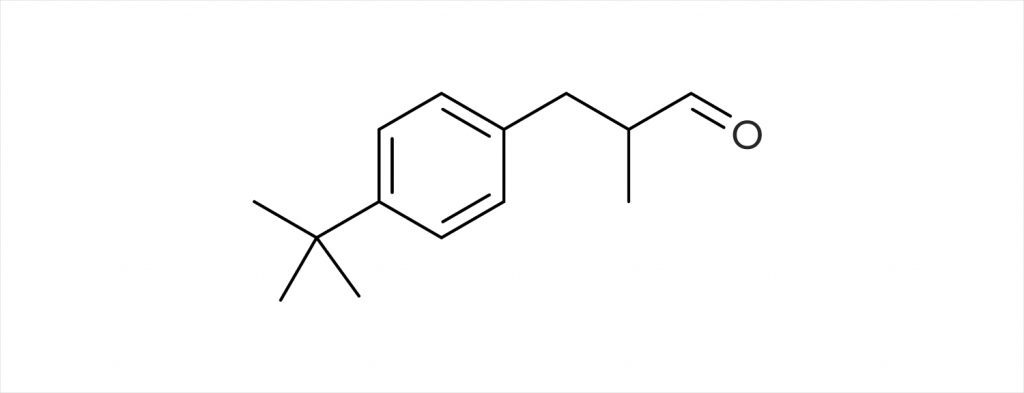What Is Butylphenyl Methylpropional?
Butylphenyl methylpropional is a synthetic fragrance ingredient that is used in a variety of cosmetics and skincare products due to its potent floral scent.
Butylphenyl methylpropional, also known Lilial or lily aldehyde, is a synthetic aromatic aldehyde. Butylphenyl methylpropional exists as a colorless to pale yellow liquid. In addition to use in cosmetics, butylphenyl methylpropional may be used in non-cosmetic products such as household cleaners and laundry detergents.

Butylphenyl Methylpropional
the good:Butylphenyl methylpropional is mainly used to improve the scent of formulations.
the not so good:Despite butylphenyl methylpropional having a low risk of sensitization some people may have an allergy to the ingredient..
Who is it for?All skin types except those that have an identified allergy to it.
Synergetic ingredients:Works well with most ingredients
Keep an eye on:Nothing to keep an eye on here.
Why Is Butylphenyl Methylpropional Used?
In cosmetics and skincare products, butylphenyl methylpropional functions as a fragrance ingredient due to its strong floral scent. It is used in aftershave lotions, bath products, bubble baths, cleansing products, hair care products, moisturizers, perfumes and colognes, shampoos, and skincare products.
Butylphenyl methylpropional is an aldehyde, which is a family of ingredients that can either be natural or synthetic. Rose, citronella, cinnamon bark, and orange rind all contain natural aldehydes. Synthetic aldehydes are created by the partial oxidation of primary alcohols. All aldehydes contain a carbonyl (C=O) functional group. The carbon atom of this functional group has two remaining bonds that may be occupied by hydrogen or any generic alkyl or side chain. If at least one of these substituents is hydrogen, the compound is an aldehyde.
Aldehydes vary in smell. For instance, most of the lower molecular weight aldehydes have an unpleasant odor, like rotten fruits. Some of the higher molecular weight aldehydes and aromatic aldehydes like butylphenyl methylpropional, smell quite pleasant and are thus used in perfumery.
Aldehydes can also boost the projection of a scent, or its sillage. Sometimes referred to as ‘lift,’ sillage is how far a scent travels away from the wearer, not how long it lasts on the skin. Sillage is different from the intensity of a scent; sillage is more of the ambient scent. However, a bold sillage can have a room-filling effect, such as when someone enters an elevator and the perfume overwhelms the space. Thus, using an appropriate amount of aldehydes in a perfume is important to find the ideal sillage: not too strong, but not too weak.
One disadvantage of using butylphenyl methylpropional in products is that this ingredient tends to slowly oxidize on storage and is not stable long term. This problem occurs with most aldehydes.
Is Butylphenyl Methylpropional Safe?
The safety of butylphenyl methylpropional has been evaluated by the Research Institute for Fragrance Materials Expert Panel. Based on this evaluation, an International Fragrance Association (IFRA) Standard has been established. The IFRA Standard restricts the use of butylphenyl methylpropional in fragrances because of potential dermal sensitization.
A research article published in the Flavour and Fragrance Journal assessed the risk of sensitization for 26 fragrances in 5451 products from 2007 to 2009. As an estimate of sensitization risk, the sensitization exposure quotient was calculated as the quotient of the relative frequency of sensitization and the relative frequency of use/labeling. The sensitization exposure quotient or risk varied greatly, with butylphenyl methylpropional at the bottom of the list, indicating a very low risk of sensitization.
Since there is a risk for sensitization with butylphenyl methylpropional, its presence must be indicated in the list of ingredients if the product contains more than 0.001% in products that are meant to be left on the skin. It also must be listed if the product contains more than 0.01% and is meant to be rinsed off, such as with cleansers and shampoos.
Due to the possibility of an allergic reaction, those with sensitive skin should try to butylphenyl methylpropional or perform a patch test with any product containing this ingredient.







